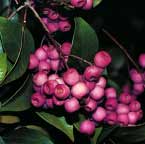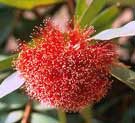February Newsletter, 2001
Lilly Pilly Fruit and Flowers
Lilly pillies are handsome rainforest trees native to Australia and south-east Asia. They have become tremendously popular throughout Australia and make truly magnificent hedging, topiary and ornamental plants. As well as having evergreen, glossy leaves often with a delightful pink to red tips and masses of fluffy flowers in late spring to summer. Then there is the edible berries which see them valued as a bush food and as a bird attractant.
Syzygium australe - The Brush Cherry is a common plant of coastal and highland  rainforests from southern New South Wales to central Queensland. Known to reach up to 25m in its ideal habitat it is usually much smaller in cultivation. The leaves are opposite, rounded and bright, glossy green in colour. White flowers are followed by large, fleshy, red fruits in profusion. These are oval in shape and around 20 mm long with a large seed. The fruits are edible and are often made into jams. They can also be eaten fresh and have a crisp, refreshing texture. It is a hardy tree in most temperate and subtropical climates and is cultivated in most Australian states. It prefers rich soils and assured moisture.
rainforests from southern New South Wales to central Queensland. Known to reach up to 25m in its ideal habitat it is usually much smaller in cultivation. The leaves are opposite, rounded and bright, glossy green in colour. White flowers are followed by large, fleshy, red fruits in profusion. These are oval in shape and around 20 mm long with a large seed. The fruits are edible and are often made into jams. They can also be eaten fresh and have a crisp, refreshing texture. It is a hardy tree in most temperate and subtropical climates and is cultivated in most Australian states. It prefers rich soils and assured moisture.
Syzygium Leuhmanii - Riberry is native to coastal sub tropical rainforest areas of eastern Australia. Crimson in colour, this pear shaped berry is rich in essential minerals with a strong aromatic flavour. It was one of the first ever Australian native fruits to be eaten by a European and Joseph Banks recorded that Captain Cook first tasted the Lilli Pilli in 1770.
Syzygium paniculatum - Magenta Cherry is a shrub or small tree with flaky bark. The leaves are opposite and bright, glossy green. White flowers appear in summer and are followed by large, fleshy, magenta-coloured fruits. These are oval in shape and around 20 mm long with a large seed. The fruits are edible and very palatable. It is a reliable species in most temperate and subtropical climates. It prefers rich soils and assured moisture. The species can be grown successfully in a large tub.
Syzygium wilsonii - Powderpuff Lilly Pilly is a shrub or small tree from 2 to over 6  metres high. The leaves are narrowly oval in shape. The spectacular new growth is red or bronze in colour and the deep red flowers are plentiful appearing in spring and early summer. The flowers are about 100 mm in diameter and are followed by white oval fruits. It is a reliable species in most temperate and subtropical climates. It is a very attractive species in both flower and foliage. It prefers rich soils and assured moisture in sun or dappled shade and makes an excellent feature plant for a large container.
metres high. The leaves are narrowly oval in shape. The spectacular new growth is red or bronze in colour and the deep red flowers are plentiful appearing in spring and early summer. The flowers are about 100 mm in diameter and are followed by white oval fruits. It is a reliable species in most temperate and subtropical climates. It is a very attractive species in both flower and foliage. It prefers rich soils and assured moisture in sun or dappled shade and makes an excellent feature plant for a large container.
Syzygium tierneyanum - The River Cherry is a fast growing lilly pilly with a dense spreading crown or dark green glossy foliage. Flushes of red and bronze new growth. Cream flowers are profuse during Summer and are a good attractant for birds and butterflies. The bunches of pinkish-red fruit are edible but most suited to jam making due to their sour taste. Plants thrive in a wide range of soils and conditions but perform best in moist well drained soil. Ideal planted for use as a windbreak or screen. Prune off lower branches to create an excellent shade tree.
Growing Avocados
Visit our website for information on the different varieties of avocadoes available. Theoretically there are enough avocadoes to provide fruit all year.
Planting
Avocados must have exceptionally well drained soil; they definitely will not tolerate wet or boggy soils. They are prone to Phytophthora cinnamomi (fy - tof - thora) that if not treated promptly can be fatal. The two most common points of infection is in the trunk at or just below ground level (Collar Rot) and the root system. To help combat this plant the tree on a mound of soil to allow the excess moisture to drain away. Ensure that the trees are protected from frost and strong winds. The best conditions are uniformly warm and humid during the flowering and fruit setting times. Hot dry winds or dry soil can cause the tree to excessive fruit shedding.
To ensure you get the best from your avocado
· Obtain your tree from a reputable nurseryman who has grown the young trees in a sterile potting mix.
· Plant your tree in deep well drained soil. This is of the utmost importance in high rainfall areas.
· Water your tree carefully. Over watering WILL increase the risk of root and collar rot.
· Establish and maintain a permanent well mulched area extending beyond the drip line of well rotted animal manure, straw, lucern mulch etc.
· Check that the mulch has not turned wet and gluggy. This can cause oxygen starvation and also increase the risk of rot. Replace with fresh mulch. Keep mulch at least 20cm away from the base of the tree.
Harvesting
Well cared for grafted trees should begin to bear fruit in their third year.
It is difficult for the home gardener to judge when the fruit is mature and ready to pick. Dark skinned varieties reach their full colour when ripe. Eg. Hass turns a purplish colour when mature. Some varieties show a slight thickening of the stem with a slight yellow tinge in the stem and skin.
As a guide pick one of the largest fruit and if it is mature, it should soften in 7 to 10 days without shrivelling. If the fruit shrinks or shrivels then the fruit is not yet mature. Never pull the fruit from the tree, always cut the stem leaving a shot piece on the fruit. If it is pulled this damages the fruit where the stem attaches and this will allow decaying organisms to enter the fruit.
Fire Retardant Planting
All plants, whether they are exotic, native or rainforest will burn when subjected to sufficient heat however some plants don't carry fire as well. If planned correctly the plants listed below will conserve moisture, serve as a wind break by absorbing and deflecting radiant heat from the fire and act as a barrier to flying sparks.
Rainforest Trees: Cassine australis, Cupaniopsis anacardioides, Diospyros australis, Eleocarpus reticulatus, Grevillea robusta, Melia azerdarch, Hymenosporum flavum, Podocarpus elatus, Rhodosphaera rhodanthema, Sarcopteryx stipata, Stenocarpus sinuatus.
Other Trees: Acacia elata, Acacia melanoxylon, Acmena smithii, Banksia integrifolia, Brachychiton acerifolius, Brachychiton populneum, Buckinghamia celsissima, Casaurina glauca, Casaurina cunninghamii, Lophostemon confertus, a selection of Pittosporum, Cassia and Grevillea species.
WHITE SAPOTE
WHITE SAPOTE
Harvesting: When picking fruit choose firm, bruise-free sapotes with green to yellow-green skin. Allow sapotes to ripen at room temperature, uncovered, out of direct sun; turn occasionally until they yield to gentle pressure, then refrigerate, unwashed, in a plastic or paper bag. They will keep 3 to 5 days.
Hot tip: We are grateful to one of our customers for this hot tip. He picks his sapotes just prior to maturity and puts them in the refrigerator for up to 2 weeks. This kills any fruit fly larvae that may have infested the fruit. The fruit is then removed from the fridge and let ripen on a window sill as usual.
Uses: White sapotes are best eaten uncooked as cooking makes them limp and less flavourful. They can be eaten alone or combined with other fresh or puree, peel, and seed them to mix with orange juice and a few drops of vanilla. This makes a delicious and refreshing drink
Nutritive Value: Sapotes contain a fair amount of vitamin A, are a good source of vitamin C, have a relatively high amount of potassium, and small amounts of other vitamins and minerals.
Basic Preparation Tips: Wash sapotes and eat as you would apples, discarding seeds. Alternatively the fruit can be peel and pitted and the pieces cut into slices. The thin immature seeds are sometimes disguised within the flesh and need to be removed carefully. Dip into or drizzle lemon or lime juice over the fruit to prevent darkening.
WHITE SAPOTE BLEND
· 1 cup peeled, seeded sapote pieces
· 1 cup plain yogurt
· ½ cup cracked ice
· 1½ Tbsp orange juice
· 2 to 3 Tbsp. honey
· ¼ teaspoon ground ginger
In a blender or food processor, combine all ingredients. Process until smooth. Pour into glasses and serve straight away.
Serves 2.





